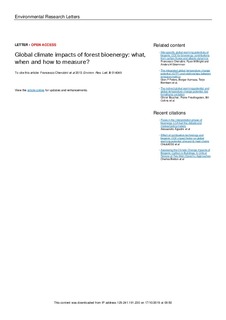| dc.contributor.author | Cherubini, Francesco | |
| dc.contributor.author | Bright, Ryan M. | |
| dc.contributor.author | Strømman, Anders Hammer | |
| dc.date.accessioned | 2019-10-25T11:25:04Z | |
| dc.date.available | 2019-10-25T11:25:04Z | |
| dc.date.created | 2013-06-17T09:44:10Z | |
| dc.date.issued | 2013 | |
| dc.identifier.citation | Environmental Research Letters. 2013, 8 (1), . | nb_NO |
| dc.identifier.issn | 1748-9326 | |
| dc.identifier.uri | http://hdl.handle.net/11250/2624444 | |
| dc.description.abstract | Environmental impact studies of forest bioenergy systems usually account for CO2 emissions and removals and identify the so-called carbon debt of bioenergy through comparison with a reference system. This approach is based on a simple sum of fluxes and does not consider any direct physical impact or climate system response. Other recent applications go one step further and elaborate impulse response functions (IRFs) and subsequent metrics for biogenic CO2 emissions that are compatible with the life-cycle assessment (LCA) methodology. However, a thorough discussion about the role of the different metrics in the interpretation of the climate impacts of forest bioenergy systems is still missing. In this work, we assess a single LCA dataset of selected bioenergy systems using different emission metrics based on cumulative CO2 emissions, radiative forcing and global surface temperature. We consider both absolute and normalized metrics for single pulses and sustained emissions. The key challenges are the choice of end point (emissions, concentration, radiative forcing, change in temperature, etc), the type of measure (instantaneous or time-integrated) and the treatment of time. Bioenergy systems usually perform better than fossil counterparts if assessed with instantaneous metrics, including global surface temperature change, and in some cases can give a net global cooling effect in the short term. The analysis of sustained, or continuous emissions, also shows that impacts from bioenergy systems are generally reversible, while those from fossil fuels are permanent.
As shown in this study, the metric choice can have a large influence on the results. The dominant role traditionally assigned to cumulative metrics in LCA studies and climate impact accounting schemes should therefore be reconsidered, because such metrics can fail to capture important time dependences unique to the biomass system under analysis (to which instantaneous metrics are well suited). | nb_NO |
| dc.language.iso | eng | nb_NO |
| dc.publisher | IOP Publishing | nb_NO |
| dc.rights | Navngivelse 4.0 Internasjonal | * |
| dc.rights.uri | http://creativecommons.org/licenses/by/4.0/deed.no | * |
| dc.title | Global climate impacts of forest bioenergy: what, when and how to measure? | nb_NO |
| dc.type | Journal article | nb_NO |
| dc.type | Peer reviewed | nb_NO |
| dc.description.version | publishedVersion | nb_NO |
| dc.source.pagenumber | 12 | nb_NO |
| dc.source.volume | 8 | nb_NO |
| dc.source.journal | Environmental Research Letters | nb_NO |
| dc.source.issue | 1 | nb_NO |
| dc.identifier.doi | 10.1088/1748-9326/8/1/014049 | |
| dc.identifier.cristin | 1034546 | |
| dc.description.localcode | Content from this work may be used under the terms of the Creative Commons Attribution 3.0 licence. Any further distribution of this work must maintain attribution to the author(s) and the title of the work, journal citation and DOI. | nb_NO |
| cristin.unitcode | 194,64,25,0 | |
| cristin.unitname | Institutt for energi- og prosessteknikk | |
| cristin.ispublished | true | |
| cristin.fulltext | original | |
| cristin.qualitycode | 1 | |

